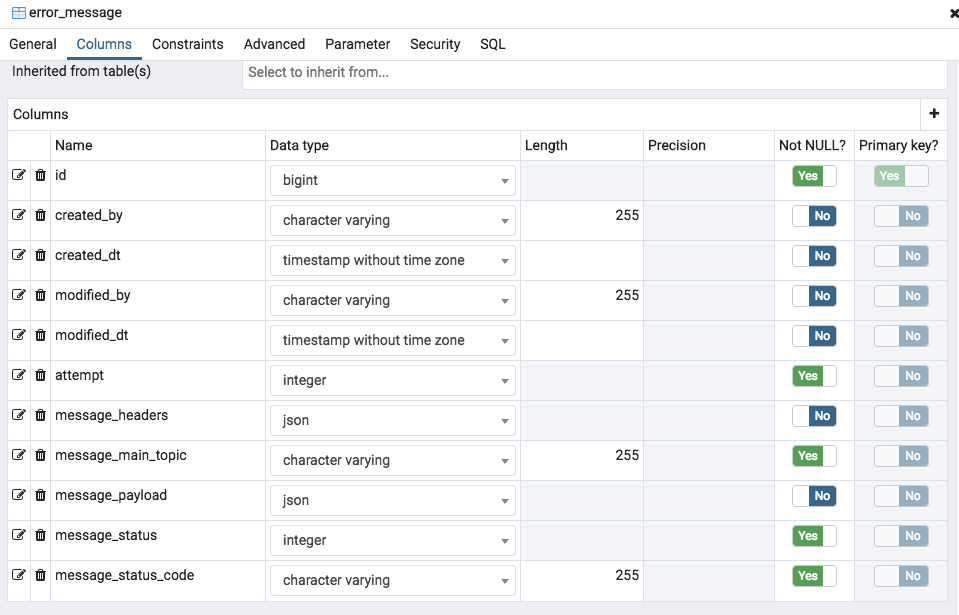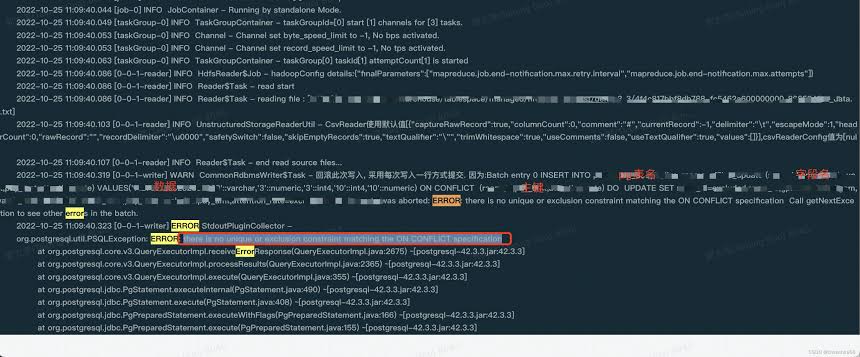There is no unique or exclusion constraint matching the on conflict specification. All answers & details below.
There is no unique or exclusion constraint matching the on conflict specification
- Example Postgres Log Output:
ERROR: there is no unique or exclusion constraint matching the ON CONFLICT specification
STATEMENT: INSERT INTO x (y, z) VALUES (‘a’, 1) ON CONFLICT (y) DO UPDATE SET z = EXCLUDED.z
- Explanation:
Your INSERT INTO. ON CONFLICT statement is missing the unique or exclusion constraint thats required to determine where a row is equivalent (i.e. conflicting) with an existing row in the table.
This may be due to the automatic inference not finding your constraint, or the more likely case that you have forgotten to specify one or more columns that identify the constraint. There is no unique or exclusion constraint matching the on conflict specification.
- You can explicitly specify the constraint like this:
INSERT INTO distributors (did, dname) VALUES (9, 'Antwerp Design')
ON CONFLICT ON CONSTRAINT distributors_pkey DO NOTHING;- Recommended Action:
Adjust your application and rewrite your query to correctly reference the exclusion/unique constraint required by ON CONFLICT.
In some cases you may also need to create the missing UNIQUE index or exclusion constraint.
Hello everyone, in this topic I will show you how we can add rows to a table. We have a table called Employees. I will choose everything from my desk workers. Here are the columns. We have an employee ID, first name, last name, hourly rate, and higher date. To add a row to a table, enter the name of the table followed by the values.
- Parenthesis:
There is no unique or exclusion constraint matching the on conflict specification. Between the set of brackets we will add all the data for one row. Employee ID, name, surname, etc. We will follow this order starting with . But we also need to pay attention to data types. Each piece of data will be separated by commas. Let’s start with an employee ID. The first employee will be Mr. Crab. He is the first employee. I will give him 1 employee id. Then we will need a name.
Since our first name’s data type is varchar, I’ll put it in quotes. Basically speaking, this is text. According to SpongeBob science, Mr. Crab’s first name is Eugene. Then we have a last name, a last name, Cancers, hourly wage. This is a decimal number. Mr. Crab’s hourly wage will be $25.50. I’m just making up numbers here.
There is no unique or exclusion constraint matching the on conflict specification. Hiring Date Here is the format of a date within a series of citations. We’ll list the year, then the month, and then the day. I will set the Mr. Crab Rental Date to January 2, 2023. Now we can apply these expressions. Yes, we’re starting. Here is the first row. Employee ID, First Name Eugene, Last Name Cancers Hourly pay 2550. Hiring date January 2, 2023.
Manually adding an expression one at a time can be a little annoying. Let’s add multiple lines at once. To do this, I will add another set of brackets after my set of brackets, each of which is separated by a comma, depending on how many lines I want to enter. So I have 4 employees that I want to enter. I’m going to add four sets of brackets, each separated by a comma, and let me do some formatting to make this look nice.
Each set of brackets corresponds to a new row, so let’s enter all the data we need for this table. Employee ID number 2 will be Squidward Tentacles. Squidward’s hourly rate, perhaps Squidward’s $15, will have a solid hiring date.

There is no unique or exclusion constraint matching the on conflict specification. The year is January 2023. I think January 3 is beautiful. All right, this is the next row. Let’s work on employee number three. Employee number three will be SpongeBob. His last name will be SquarePants. SpongeBob’s hourly wage will be 1250. SpongeBob’s rental date is January 4, 2023.
The fourth employee will be Patrick Star. Patrick’s hourly rate will also be 12:50. Recruitment day 2023 5 January. Last employee employee ID number 5, first name Sandy.
Cheeks Sandy’s hourly rate will be 1725. He will be the assistant principal. Sandy’s start date will be January 6, 2023. We can run this statement to insert multiple lines at once. Yes, here is our table. We have 5 rows, each corresponding to a different employee. We have Mr. Crabs.
There is no unique or exclusion constraint matching the on conflict specification. Squidward, SpongeBob, Patrick and Sandy. I’ll show you what happens when we try to insert a row with missing data. I’ll add employee number six. First name Sheldon, Last name Plankton. However, we will not enter an hourly rate or a higher date. Here’s what will happen. So we have an error.
The column count does not match the count value in the first row. We are missing data for our hourly pay and hire date. You can only add selected columns. This is done by appending it after the table name. Add a series of brackets, then name the columns you want to add data to. All we add is an employee ID, first and last name.
Ok, now we’ve added a new employee, but the data is missing and that’s fine. We plan to hire Mr. Plankton, but have not yet negotiated an hourly rate or start date. We still need to check its history, but at least we want to add it to the system. So, if you need to add data to a row but skip certain columns, you can only list the name of the columns you want to search data for. Alright folks, this is how rows are inserted into a table in MySQL. There is no unique or exclusion constraint matching the on conflict specification / video. https://pganalyze.com/docs/log-insights/app-errors/U125
- Convert 42 Celsius To Fahrenheit
- The Materiality Constraint As Applied To Bad Debts
- What Percent Of A Standard Normal Model İs Found İn Each Region? Draw A Picture First.
- What is the domain of the function mc007-1.jpg? mc007-2.jpg mc007-3.jpg mc007-4.jpg mc007-5.jpg.
- What İs The Domain Of The Function Shown İn The Mapping?

